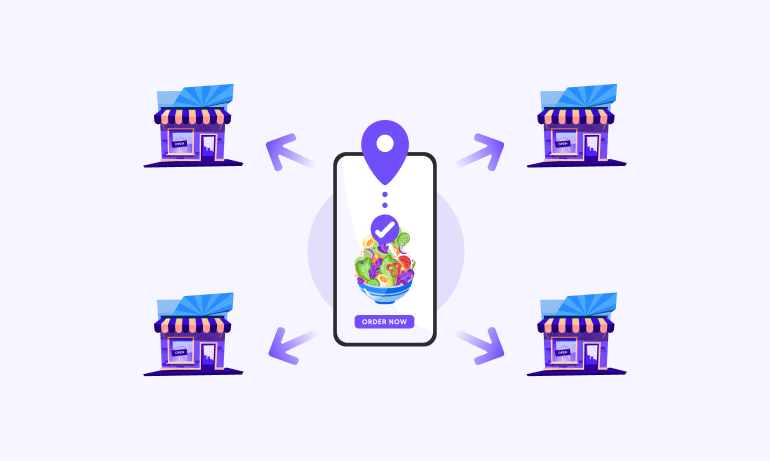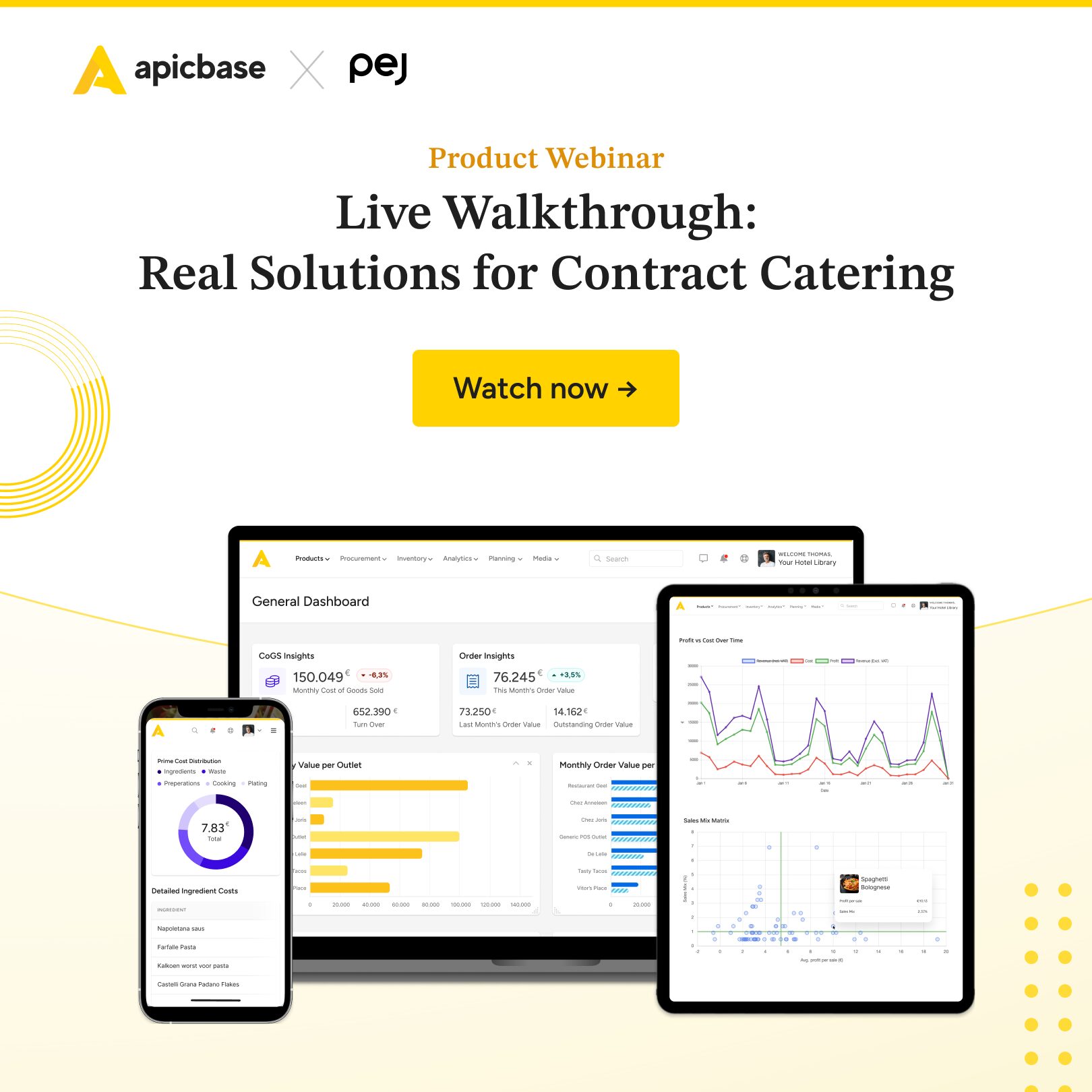If one thing is certain, consumers want food delivered to their homes ready to eat.
The European Online Food Delivery Market is projected to reach US$ 66.2 Billion by 2027 with a 10,7% year over year growth. Let those numbers sink in for a second.
That’s massive.
New avenues for revenue and growth are opening up fast.
The demand for food delivery is so enormous that we’ve already reached a point where it’s possible to develop a profitable foodservice business based solely on online orders.
That is the virtual restaurant model.
This article explains the ins and outs of starting a virtual restaurant brand and growing it into a robust franchise.
We cover the following topics:
- What is a virtual restaurant?
- Rise of online-only brands
- How to start a virtual restaurant?
- Dark kitchens vs Host kitchens
- Virtual restaurant franchise: How to make it a success
- What will the future bring?
Let’s get the definition on point first.
What Is A Virtual Restaurant?
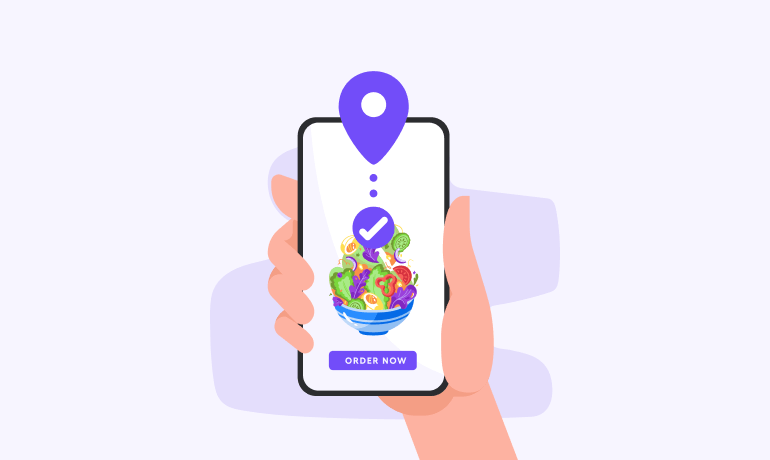
Virtual restaurants operate 100% online.
There is no physical location, no dine-in area or storefront. Customers can order meals solely through the apps of food delivery aggregators such as Doordash, Deliveroo, Glovo, Just Eat and Uber Eats.
A virtual restaurant is a restaurant in name only. The traditional definition of a restaurant doesn’t apply because there is no sit-down area or wait staff, nor is there an immediate relation to a specific kitchen operation.
Virtual restaurants essentially are online menus optimised for delivery and promoted through food ordering apps. Therefore virtual restaurants are often called ‘brands’, as in ‘virtual restaurant brands’ or virtual brands.
Because virtual restaurant brands are online-only concepts, any professional kitchen can prepare the food. Depending on the business model, this is a restaurant kitchen, a dark kitchen or a host kitchen.
Rise Of Delivery-Only Restaurants
Virtual restaurants are everywhere in the US. Companies like NextBite Brands and Virtual Dining Concepts (of the famous MrBeast Burger) create and operate several delivery-only brands.
A report by Grubhub (2022) states that 41% of independent restaurants in the US currently operate virtual brands to leverage persistent consumer delivery demand. 68% of survey respondents report their virtual restaurants are permanent additions, and 46% plan to open three or more virtual concepts in the next 12 months. Also according to the report, restaurants that offer virtual brands offer five unique virtual concepts on average.
Traditional restaurant chains too have ‘built’ virtual restaurants apart from their brick-and-mortar outlets. For example, Blooming Brands, owner of Outback Steakhouse, launched Tender Shack, and Dine Brands Global, owner of Applebee’s, introduced Cosmic Wings.
The model, meanwhile, is gaining ground in Europe. Notable examples are Bright Kitchen, a company based in the Netherlands, Not So Dark from France, Peckwater Brands in the UK and Rocket Restaurants from Ireland. All operate and franchise several virtual restaurant concepts in major cities and plan to expand to more areas and countries.
How To Start A Virtual Restaurant?
The virtual restaurant model has a lot of growth potential. Moreover, the barriers to entry are low, as it removes the cost and effort of managing an efficient front-of-house.
Opening a virtual restaurant is not that complicated, but creating a successful brand is.

Rens Bekkers
Co-Founder, Bright Kitchen, The Netherlands
We asked four brand developers about starting a virtual restaurant — Not So Dark, Peckwater Brands, Bright Kitchen and Rockets Restaurants.
We found there are five essential steps.
Let’s have a look.
5 steps to open a virtual restaurant brand [that will rake in delivery orders]
#1 Find the right concept
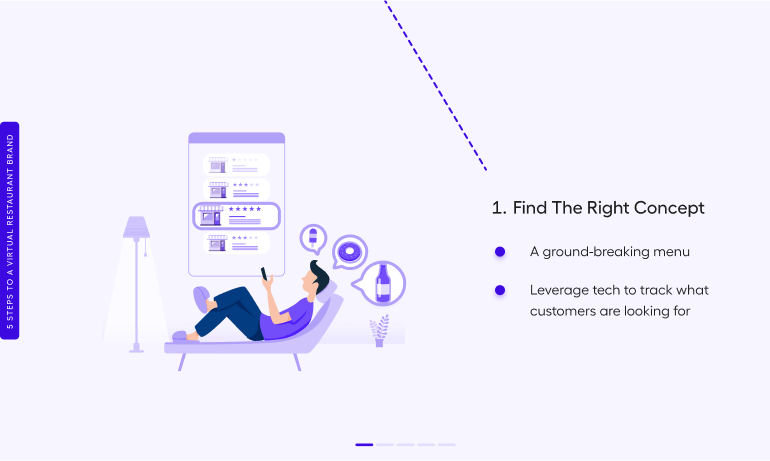
It seems simple enough: create a menu that has the potential to hit it big on third-party delivery apps.
‘The food on offer in the delivery sector is so varied you need tech to measure what consumers in your area want,’ says Clément Benoit, co-founder of Not So Dark. ‘Modern software enables us to rely on data from thousands of restaurants worldwide, assess future trends, and determine which recipes work in particular areas.’
#2 Test your idea in the market
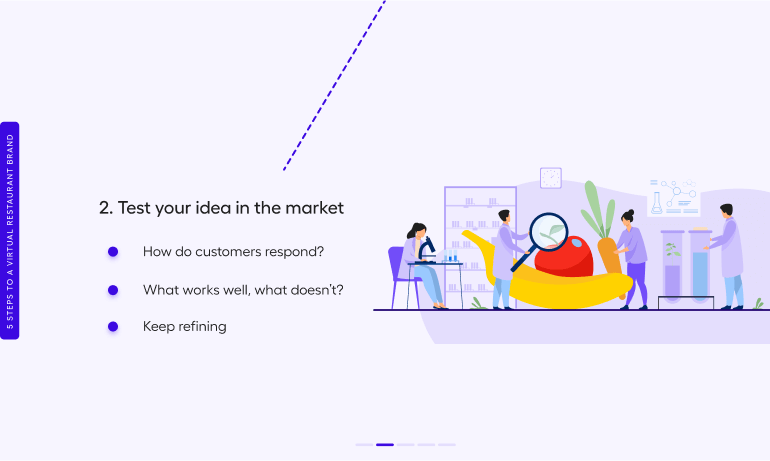
No matter how extensive your research, you can never be sure of a concept’s success until you see how real customers respond to your idea.
Having an idea for a virtual brand and turning it into an overnight success makes for a great inspirational story. Unfortunately, the reality is less glamorous.
‘A more realistic scenario is that you come up with 100 ideas, try out 60, and release 20. Of those 20, only one will be a huge success,’ says Bekkers. ‘We have seven brands now, but we started with 30. One of those seven, Vegan Burger Brothers is one of Amsterdam’s most popular online restaurants. Nonetheless, the whole development process is rewarding because it creates a lot of value once you’ve found what works.’
Thanks to third-party delivery apps, brand developers can go online and test menus instantly. They can switch menus on and off in a heartbeat, allowing them to tweak menus, reframe photos, change names and pricing until it’s just right and starts raking in online orders.
#3 Optimise costs
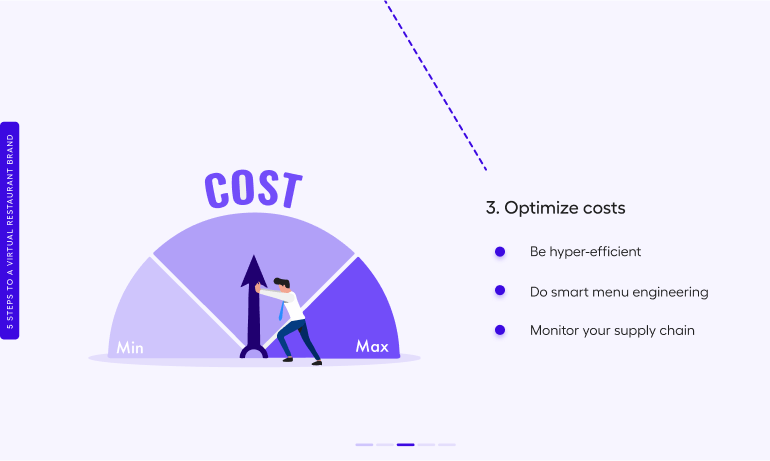
An essential part of profitability comes from offsetting third-party delivery costs.
‘The last mile, which we outsource to multiple delivery apps, makes up 30% of our costs,’ says Bekkers. ‘As a virtual brand, you need to find efficiencies in terms of food cost and labour cost to make up for those expenses.’
It requires a hyper streamlined operation, intelligent menu engineering, and a lean supply chain.
Also read: Restaurant Menu Costing — How to Automate Recipe Calculations & Eliminate Low-Margin Items
‘At Bright kitchen, for example, we were able to close the gap between our theoretical and actual food cost by focussing on the data.’
#4 Focus on quality

Once you’ve found a concept that works and optimised it for profitability, you need to look at quality: ‘This is where it becomes challenging,’ says Bekkers.
‘The market is highly competitive. In the Netherlands, 800 restaurants are online. 80% of orders go to 10% of those restaurants. The competition is fierce, and people expect the highest quality. To make it in the delivery space, you have to meet that level of quality and, at the same time, be hyper-efficient with costs.’
Recommended reading: 24 Ways To Reduce Costs And Boost The Bottom Line of Your Cloud Kitchen
‘At Not So Dark virtual brands have to undergo an internal validation process before being launched,’ says Clément Benoit, co-founder Not So Dark. ‘The best menus result from months of research and development with focus groups and menu scoring, packaging testing, etc.’
#5 Do your marketing right

Even the best virtual brands won’t last long without proper marketing. The competition is intense.
For Benoit, ‘to stand out from the crowd and establish a solid reputation for your brand, you need impactful advertising, be present on the social networks, and find relevant partners. The worldwide Veganuary movement, for instance, is a fantastic opportunity for a virtual vegan brand to boost its reputation and attract a large audience for its recipes.’
For Bekkers, setting up a website may not always be the right choice from a marketing point of view. ‘For some of the concepts, we have a website; for others, we don’t.’
‘Currently, we’re working on paid awareness campaigns, mainly on social channels, such as Instagram and Facebook, where we bring visitors directly to UberEats or Deliveroo. After all, that’s where the majority of the orders come from.’
‘When people are hungry, they open an app. It’s how it is. That’s why it’s important to have visibility in the delivery apps. A website will get you traffic. The question is, how relevant is that traffic? Are you able to convert visitors into paying customers?’
Dark Kitchens vs Host Kitchens
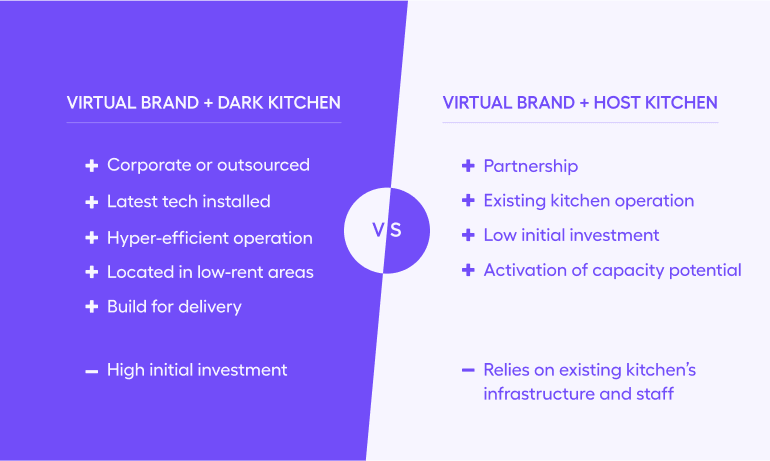
Let’s talk about food production for a second.
Contrary to a traditional restaurant where a chef develops and prepares the menu, a virtual restaurant separates the two.
On the one hand, you have the people developing the virtual brands, and on the other hand, you have the operators preparing the orders for delivery. The same company can do both, but it doesn’t have to be that way.
For example, during recent lockdowns, Rocket Restaurants optimised and marketed a set of menus specifically for delivery. These menus were prepared in their existing restaurants and handed to delivery drivers through the backdoor.
These days, the production of virtual brands often happens in specialised dark kitchens (aka ghost kitchen or cloud kitchens) because they are more efficient and cost-effective.
However, there is a downside to dark kitchens, says Sam Martin, co-founder and COO of Peckwater Brands. ‘Dark kitchens offer many benefits. They require no front of house space or staff and can be located in low-rent areas. Also, a single dark kitchen can simultaneously prepare food for several virtual restaurants. The downside is the high initial investment, ‘ says Sam Martin.
By incorporating a virtual brand into an existing kitchen operation, you exclude the high start-up costs of a dark kitchen.

Sam Martin
Co-Founder & COO, Peckwater Brands (UK)
He points to an alternative solution that doesn’t require a high initial investment: ‘incorporating a virtual brand into existing kitchen operations via franchising.’
Interesting? Yes!
Let’s take a closer look at the virtual franchise model.
Virtual Restaurant Franchise: How To Make It A Success
Virtual brands are ideal for franchising because they have no connection to a physical location. Every commercial kitchen can prep the menu items for delivery.
Virtual franchising is on the rise. For many online-only restaurant concepts in Europe, it’s becoming central to their expansion strategy.
What is a virtual franchise?
A virtual franchise is a business model (also known as brand licensing and host kitchen model), where independent restaurant operators with spare kitchen capacity prepare the orders of virtual restaurant brands during the downtime of their own restaurant operation.
Peckwater Brand’s research found that 67% of surveyed restaurants have the capacity to accommodate more orders in their kitchens in terms of space or labour. Virtual brands can activate that untapped capacity and significantly increase an operator’s bottom line.
For the customer, there is no difference, Rens Bekkers of Bright Kitchen explains: ‘The experience of ordering from a virtual restaurant is very similar to that of online retailers like Amazon. Customers know there is a kitchen that prepared the food, but where that operation is located is less relevant to them.’
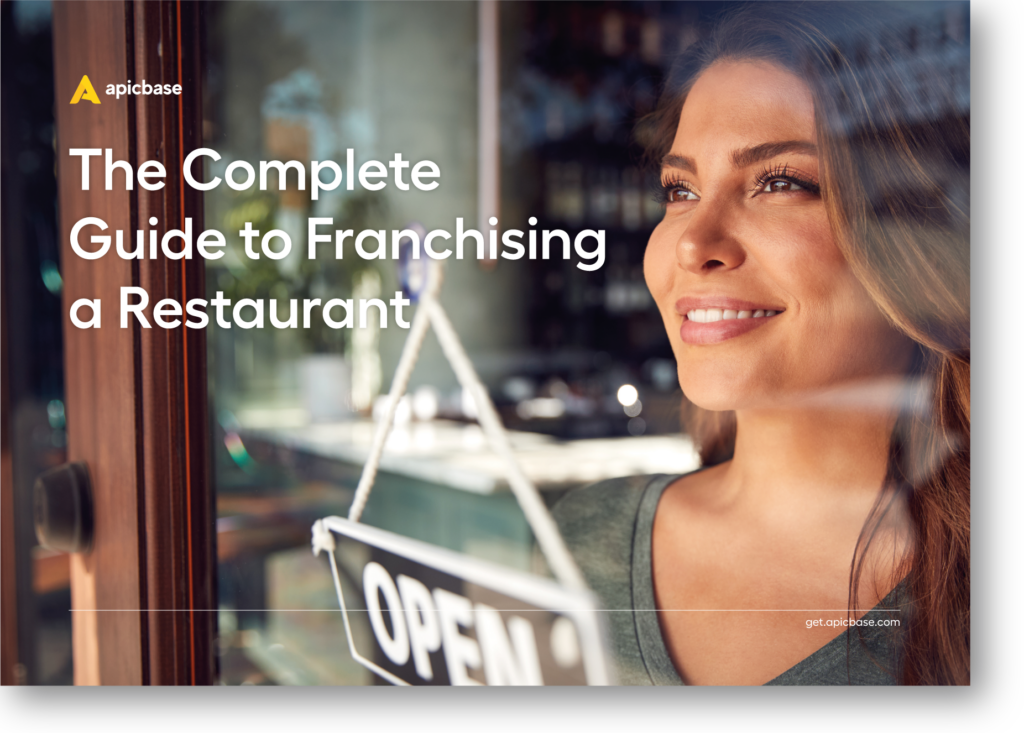
How To Franchise A Restaurant?
Develop your franchise using a proven roadmap for franchisors.
✅ Free download
What’s in it for the host kitchen?
Done right, the brand licensing model is a win-win for both franchisor and franchisee (aka licensee).
For the virtual restaurant company, it’s a way to reduce the overhead costs of setting up a fully equipped kitchen. The company can focus all its attention on creating successful online brands.
For host kitchens, it’s a way to earn extra revenue by leveraging the unused potential of their existing infrastructure. They don’t have to invest in additional resources or worry about menu development. The host kitchen teams can focus on what they do best: preparing delicious meals.
‘Every restaurant pays for electricity, staffing, equipment and rent. These resources aren’t always fully utilised’, says Rens Bekkers. ‘There is an insane amount of excess kitchen capacity that can help offset fixed costs. For example, restaurants with two free workbenches; hotels that use their kitchen mainly for room service and breakfast; coffee places with a proper kitchen that closes at five o’clock; or catering companies that make all their revenue between 11 AM and 3 PM.’
Restaurateurs can use delivery-only brands to bolster their business during off-peak hours.

Tobi Lukaschek
Business Development at Rocket Restaurants, Ireland
Tobi Lukaschek from Rocket Restaurant adds: ‘An established delivery-only brand will provide the restauranteur with the know-how, tools, training and technology. Done right, restaurateurs can use delivery-only brands to bolster their business during off-peak hours and increase productivity during peak times.’
How to win at virtual restaurant franchising?
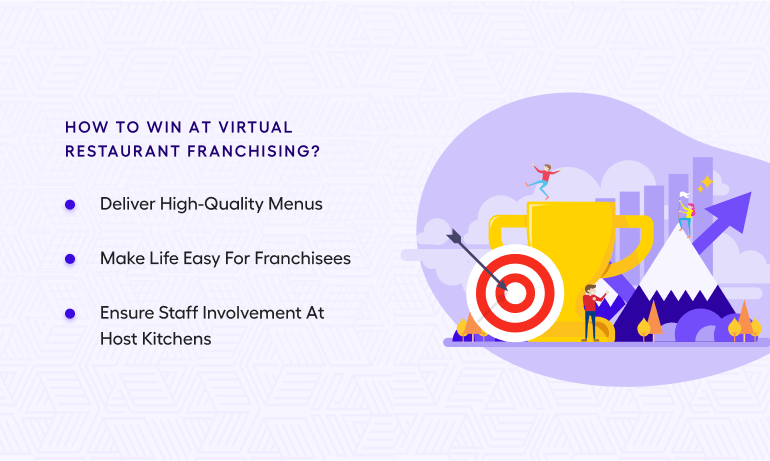
A virtual franchise is a lightweight version of a regular restaurant franchise, but the same basic rule applies: it’s a partnership.
Success depends on the quality of the support provided by the franchisor. And equally on the franchisee’s commitment to delivering high-quality meals. Host kitchen operators have to closely follow the franchisor’s instructions — from purchasing ingredients to prep and packaging.
Recommended reading: Pitfalls of Starting a Restaurant Franchise
A franchise is always a two-way street, so keep the following in mind:
Make life easy for your franchisees
For a partnership to be successful, the franchisor must make life as easy as possible for their franchisees.
‘A company that creates virtual restaurant concepts needs to offer their partners a turnkey package, including expertise in food delivery, marketing, packaging and pricing,’ says Clement Benoit, co-founder of Not So Dark. ‘From the choice of ingredients to the packaging, everything has to be perfected by the franchisor to guarantee the best possible customer experience.’
Speed and quality are key. ‘Kitchen staff should be able to complete a recipe in less than 5 minutes. Virtual brands mustn’t disrupt a restaurant’s front-of-house operations. The restaurant owner should be able to run virtual brands in his kitchens without burdening on-premise operations.’
The restaurant owner should be able to run your virtual brand without burdening their on-premise operation

Clément Benoit
Co-Founder & CEO, Not So Dark (France)
If you want to turn your virtual franchise into a success, nothing can be left to chance. Not So Dark, for example, offers continuous supervision, technical assistance and 24/7 customer service to its partners.
Rens Bekkers agrees: ‘the model has to be lean. When it comes to our Vegan Burger Brothers brand, the only thing a kitchen has to do is: buy the ingredients, prepare the food, and hand the meal to the rider. We take care of everything else: marketing, handling delivery platforms, and creating recipes that are optimised for delivery, including fully documented step-by-step guides.’
Staff involvement is crucial
Staff involvement is essential for the successful onboarding of a host kitchen.
‘Next to having kitchen space, our number one requirement for a licensee is having the right mindset,’ says Bekkers. ‘It’s a true franchise partnership even though it has ‘virtual’ in the name. It won’t work when it’s just the boss in his high chair saying: I want a virtual brand because I like the extra revenue. The whole team has to be involved and dedicated to delivering quality.’
As a franchisor, you are building a brand. One bad review can sink your efforts. So it makes total sense to view the partnership in light of a full-on franchise restaurant, even if the investment for the host kitchen is negligible. The start of the Mr Beast Burger franchise serves as a painful reminder of how not to launch a virtual restaurant.
Future of Virtual Restaurant Concepts

During the pandemic, food delivery became a lifeline for many restaurateurs who, often begrudgingly, had to resort to third-party ordering apps to keep their business afloat.
But taking a menu that was developed for on-premise dining and making it profitable for home delivery turned out to be unpredictable at best. Like with any other business model, experience is key.
Virtual brand engineers have funnelled their expertise into a plug-and-play model allowing restaurant operators to step into the delivery market and, in theory, be profitable straight off the bat.
Having said this, it’s still early days for virtual brands.
We have to remain cautious about the model’s sustainability. We can say for sure that it’s not for every type of business. Restaurant owners need the capacity and the right mindset to make it work. Brand owners need the right tech, expertise and support system to build a thriving virtual restaurant franchise, with the emphasis on ‘franchise’, as in a partnership.
On the other hand, what is also sure, is that online ordering and delivery are here to stay. With brand licensing, virtual restaurants have proven that it’s possible to create growth opportunities both for themselves and for traditional brick-and-mortar restaurants.
Success stories are popping up everywhere.
A notable one is Wow Bao. In a comment on Linkedin CEO Geoff Alexander wrote:
Less than 3 sq ft of space can generate $100,000+ sales annually, with 40+% flowing to the operator’s bottom line. We have launched 600+ Wow Baos and are now launching our Plant-Based Protein brand, Skinny Butcher’s Crazy Crispy Chick’n.

Geoff Alexander
President & CEO, Wow Bao
You can’t argue with those numbers.👆


